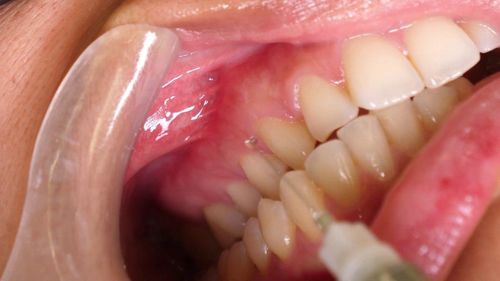This is an automatically translated article.
The article was professionally consulted by Specialist Doctor II Dinh Van Loc - Department of General Surgery - Vinmec Danang International General Hospital.
Aortic aneurysm is a disease when the aorta in the patient's body is enlarged, complicated to become a rhombus, or a sac, causing the wall of the vessel to stretch and rupture easily. If the disease is not detected and treated promptly, it can be life-threatening.
1. The dangers that abdominal aortic aneurysms cause
The most dangerous complication of aortic aneurysm is rupture of the blood vessel at the site of the aneurysm, leading to death for the patient. In addition, the disease also leads to complications such as: acute blood loss, shortness of breath, chest pain, low blood pressure, pale skin.The main cause was found to be related to trauma or uncontrolled high blood pressure in time.

Vỡ động mạch chủ bụng có thể dẫn đến tử vong nhanh chóng
2. Signs of abdominal aortic aneurysm
Most cases of abdominal aortic aneurysm have no specific symptoms, which can be discovered incidentally by computed tomography or ultrasound.The most prominent symptoms of patients with an abdominal aortic aneurysm are: Abdominal pain, feeling like a pounding mass in the abdomen, or indirect signs because the aneurysm is causing pressure on nearby organs such as duodenum and ureters. In particular, some patients will experience signs of rupture or threatened rupture such as: sudden and severe abdominal pain, accompanied by a drop in blood pressure.
Preoperative evaluation: Preoperative optimization should be focused on the treatment of concomitant lung diseases. Stopping smoking a few days before surgery is more dangerous than continuous use. This may be due to the increased mucus production and cough commonly seen in people who have recently stopped smoking
Coronary angiography or recent ischemic testing without signs or symptoms of recurrence, or those with small signs of cardiovascular risk stratification with moderate tolerance. If patients have major predictive cardiovascular findings with increased surgical cardiovascular risk, they should be referred immediately for preoperative coronary angiography. All other patients should undergo noninvasive testing.
3. Anesthesia for laparoscopic abdominal aortic aneurysm surgery
Endotracheal anesthesia is the technique of general anesthesia and intubation with the aim of controlling the patient's breathing during surgery as well as post-operative resuscitation.Anesthesia is the first step in laparoscopic abdominal aortic aneurysm surgery, which includes the following steps:
Anesthesia technique
Endovascular aneurysm repair can be performed using different anesthetic techniques , such as general anesthesia, regional anesthesia, and local anesthesia with sedation. The effect of anesthetic technique on the procedure has not been determined; however, there are times when one technique is more beneficial than another.
General anesthesia is the technique of choice for retroperitoneal procedures, respiratory failure, coagulopathy, the use of esophageal ultrasound, long-term surgery, or the patient's refusal to receive regional anesthesia.
Several techniques of spinal anesthesia have been used successfully in endovascular surgery, and this appears to be the technique of choice for most patients with abdominal aneurysms. Prevention of surgical stress response to intubation-related intubation, reduction of inflammatory response, non-ventilation in patients with severe pulmonary and cardiac disease, and post-operative analgesia , is one of its main advantages.
The use of epidural and subdural anesthesia with and without catheterization, in addition to epidural anesthesia combined with spinal anesthesia has been applied. The use of continuous dural or subdural blockade appears to be the technique of choice in most centers. When deciding to use spinal anesthesia, one should be aware of the time interval required between the duration of action and the time to neutralize heparin) to reduce the variability of the epidural hematoma.
Local anesthesia combined with sedation is also widely used.
Regardless of the anesthetic technique chosen, this decision should be based on the duration of the procedure and the experience of the surgical team, prior discussion with the surgeon and preparation for the possibility of internal anesthesia required. trachea immediately for open surgery.
Patient's position: The patient lies on his back, breathes 100% oxygen at a dose of 3-6 L/min at least 5 minutes before induction of anesthesia. Then install monitoring equipment and establish highly efficient transmission lines. Use pre-anesthesia (if needed). Induction of anesthesia: Using sleeping pills, volatile anesthetics such as sevoflurane, or intravenous anesthetics such as propofol, etomidat, ketamine,... Painkillers such as: morphine, fentanyl, sufentanil... muscle: rocuronium, vecuronium, succinylcholine,... Intubation: The condition to be able to install a tracheal tube for a patient is that the patient is in deep sleep and has enough muscle elasticity (there are two installation techniques). placement of a tracheal tube that is through the nose and mouth).

Đặt ống nội khí quản duy trì hô hấp cho bệnh nhân
The average fluid requirement is 1500-2000 mL.
Results of a multicenter study comparing blood loss between open and endovascular surgery demonstrated 60% lower blood loss endovascular (650 mL) compared with open surgery (1,600 mL), resulting in a reduction need for blood transfusion during endovascular procedures (12% vs 40%).
On the other hand, the anesthesiologist should choose the most adequate perfusion technique, keeping in mind that the patient is anticoagulated, maintaining good fluid balance during and after surgery to reduce the incidence of contrast-induced renal injury used during the procedure, provide suitable conditions for stenting, and be prepared for surgical conversion.
Anticoagulants should be monitored periodically to maintain ACT approximately 250 seconds, which means additional doses of heparin are needed during prolonged procedures. At the end of surgery, protamine is used to reverse the effects of heparin. Some authors prefer to wait for ACT normalization without protamine to avoid harmful consequences of use.
Episodes of hypotension can be achieved by several techniques to maintain mean arterial pressure of about 60 mmHg as needed during stenting. Some studies indicate the use of nitroglycerin or sodium nitroprusside; As an alternative, the dose of the volatile anesthetic may be increased or an additional dose of local anesthetic may be administered via the catheter if the patient is in persistent block.
Some authors used intravenous esmolol and adenosine to promote bradycardia and ventricular contraction during stenting. The goal of this technique is to prevent stent displacement due to systolic flow during arterial repair. However, this technique was used when endovascular surgery was first implanted, when the stent expansion time was much greater. With the advancement of technology and with new stent models, stent expansion time and stent migration rates have decreased, reducing the systolic and blood pressure requirements and, consequently, their consequences. Adenosine is commonly used in the treatment of supraventricular tachycardia because rapid injection causes a decrease in heart rate, and even complete A-V blockade, a short-acting drug, with hemodynamic stabilization within 10 seconds.
4.6 Criteria to be able to extubate the patient The patient is awake, can follow the instructions of the medical staff. The patient's head can be raised for more than 5 seconds, with a TOF > 0.9 (if present). Breathe spontaneously, with respiratory rate within normal limits. Pulse and blood pressure are stable. Body temperature > 35oC. There were no complications of anesthesia or surgery.

Kỹ thuật đặt nội khí quản
5. Follow-up after surgery
Although considered a minimally invasive procedure, several complications are associated with endovascular aneurysm repair; Among them is the rupture of an aneurysm, which can be a catastrophic event and requires immediate intervention. Risk factors for this complication include: the location of the stent and its size. Hypotension may result from improper stenting or displacement leading to vascular occlusion or incomplete exclusion of an aortic aneurysm (endoleak), distal arterial embolism with atherosclerotic plaques. or thrombosis, ischemia. A good intravenous access must be available for rapid replacement and continuous IABP monitoring. The differential diagnosis of hypotension includes sympathetic blockade, in the case of subdural or epidural masses, allergy to contrast, and use of vasodilators.The intra- and postoperative risk of myocardial infarction as well as stroke cannot be ignored. Stroke is predominantly ischemic or ischemic and aortic atherosclerosis is an independent risk factor for this severe complication. It is extremely important to maintain sinus rhythm, as atrial fibrillation is one of the causes of stroke.
Possible spinal ischemia and the role of spinal fluid drainage to preserve spinal perfusion in open surgery, although widely used, remains controversial. Some authors use this technique in endovascular surgery, besides avoiding hypothermia and hypotension.
Post-stent implantation syndrome may develop, which is characterized by fever, elevated C-reactive protein levels, and leukocytosis in the absence of infection. It lasts two to 10 days and responds to the effects of non-steroidal anti-inflammatory drugs. The development of a significant inflammatory response secondary to endothelial activation by stent manipulation is thought to occur. Occasionally, severe hypokalemia secondary to excessive capillary permeability, decreased venous return, respiratory failure due to excessive capillary permeability, and disseminated intravascular coagulation may develop.
It can be seen that endoscopic anesthesia for abdominal aortic aneurysm surgery helps control the patient's pain during surgery extremely effectively. Accordingly, any error in this process can also cause danger to the patient's life. Therefore, you should choose reputable medical facilities to perform anesthesia, surgery, ensure safety and no complications.
Vinmec International General Hospital is one of the hospitals that strictly applies safe surgical anesthesia practice standards according to international guidelines. Vinmec has a team of experienced anesthesiologists and nurses, modern equipment such as: nerve detectors, ultrasound machines, Karl Storz's difficult airway control system, comprehensive anesthesia monitoring system GE's AoA (Adequate of Anesthesia) including monitoring of anesthesia, pain and muscle relaxation will provide high quality and safety, helping patients to have adequate anesthesia, not wake up, and do not have residual muscle relaxants after surgery.
Doctor Dinh Van Loc graduated as a General Doctor in Hue in 1990, graduated as a Specialist Doctor in 2003 and as a Specialist Doctor in Anesthesiology and Resuscitation in 2017. Dr. Loc received advanced training in Anesthesiology. Anesthesiologist and has more than 23 years of experience in pediatric intensive care anesthesia, cranial nerve anesthesia, anesthesia resuscitation for liver surgery, esophagectomy at the Hospital.
To register for examination and treatment at Vinmec International General Hospital, you can contact Vinmec Health System nationwide, or register online HERE.
MORE:
How dangerous is aortic aneurysm and how is it treated? Warning signs of thoracic aortic aneurysm Aortic aneurysm: In which case is a stent graft placed?














